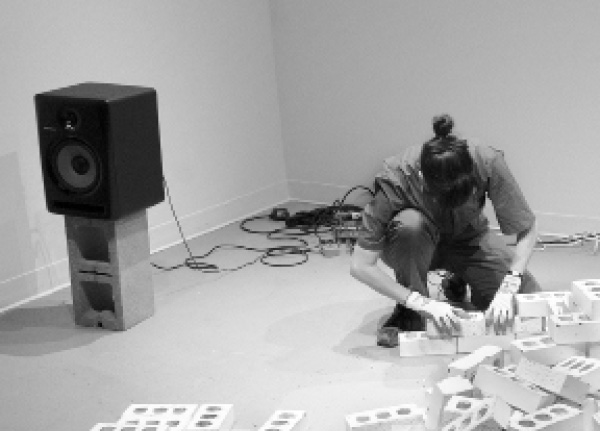
OCCUPATIONAL ENTERPRISES
first performed on November 10, 2017
Space Camp Gallery, Baltimore, MD
performed once in 2017
CARRIE FUCILE
Baltimore, MD
047247692c047247692t047247692f047247692u047247692c047247692i047247692l047247692e047247692@047247692g047247692m047247692a047247692i047247692l047247692.047247692c047247692o047247692m
carriefucile.net
OCCUPATIONAL ENTERPRISES
CARRIE FUCILE
“Occupational Enterprises” is a performance where I rearrange two-hundred white bricks into a series of structures for sixty minutes. Each one is toppled before building another. The sound of the moving, stacked, and collapsed bricks is transmitted by a contact microphone attached to the floor and distorted by a series of effects.
This piece is inspired by several texts as well as personal history. Hito Steyerl, in her essay “Is a Museum a Factory?,” observes that many places where employees worked on factory lines have recently been transformed into sites of artistic labor. Indeed, many cultural institutions and artist studios are in former industrial spaces. The enterprise may seem more glamorous, but the problems are similar. Our forebears were underpaid for laboring long hours in dangerous circumstances. Today’s cultural sector exploits poorly-compensated administrators, unpaid interns, and uninsured artists to produce value at the top of the field. The art world mirrors our society, in which income inequality is exacerbated by a crowd-sourced, freelance economy.
The piece also references my ancestors, who were Italian-American industrial workers. While researching this project, I also read Pietro DiDonato’s novel Christ in Concrete, which tells the story of an Italian immigrant bricklayer who is killed on the job due to unsafe conditions and whose eldest son is forced to leave school to support his family.
All of this provokes questions about how we, as artists, relate to our working-class forebears and contemporaries. Artists might see themselves as free from class, but no matter where we exist on the totem pole, we are either subject to the art world’s hierarchies and unfair systems or we become part of the network that perpetuates them. We occupy low-income neighborhoods, due to our need for affordable space, only to become agents of gentrification and class stratification. This performance explores these issues at a time when much soul searching is needed in the quest for social equity.